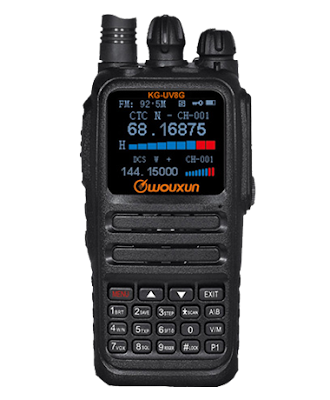The 23cm band is the lowest in the spectrum of microwave bands available to the Amateur Radio operator. With the advent of the new transceivers, it is now possible to make inroads to this band with little difficulty. The power levels of 10 watts are suffient to drive linear amplifiers and more than enough for point-to-point QSOs with reasonable antennas.
The 23cm band is popular for Moon bounce, ATV and Satellite operation and proves an interesting challenge for point-to-point communication.
Unlike the 2m and 70cm bands, it is not enough to put up a vertical colinear and expect miracles on this band. Yagi antennas from 28 element (15.4 dBd gain) to 67 element (19.9 dBd gain) versions are effective and affordable. Because of the short wavelength of the 23cm band, it is possible to produce an antenna with a greater number of elements for and hence a larger gain for a given boom length.
A 23cm Yagi with 70 elements
There are a number of transceivers available with the most recent being the ICOM IC-9700 capable of 2m, 70cm and 23cm. The Kenwood TS2000X was popular and also the ICOM 9100.
ICOM IC-9700
An alternative to a dedicated transceiver would be a transverter from 28 to 1296Mhz or from 144 to 1296 MHZ. In many cases it is practical to locate such devices just below the antenna to reduce feeder losses. Transverters are available from SG Labs, Kuhne Electronis and Downeast Microwave.
SG Labs 23Cm Transverter
DownEast Microwave Transverter with 50W Linear AMP
The Down East Microwave Transverter above is driven by an FT 817 on 28 MHz. Up to 50 Watts output on 1296 MHz
There is no harm in considering a mast-head receive preamp to overcome any signal loss in the coax although it is possible to conduct most portable activities without one.
It is essential that low-loss coax feeder is used for 23cm operation RG 213 is totally out of the question.
Modes of Operation
Obviously SSB, CW and weak signal modes are of major interest as one is seeking DX contacts. Digital Voice Modes will give some stunning results and are worth trying if you are using the ICOM 9700. Experiments were performed with this system using D-Star between two locations with low power on 1296.200MHz and signals just above the noise level. The results were surprising. The signal sounded like a fully queting FM signal coming in at a strength 9.
Propagation on 23cms
It is necessary to have some comprehension of Microwave techniques and the propagation of signals on the 23cm band. 23cms is not confined to line of sight activity and may derive benefit from tropospheric lift conditions due to high pressure weather fronts. During extreme tropospheric ducting, signals may travel further than on VHF. Those living on or near coastal areas may find that some very stable ducts form above the sea alowing considerable distances to be worked. Rapid fading may also be experience in much the same way as experienced on 70 cms.
Tropospheric Ducting
Enhanced conditions will be less frequent on 23cms than on VHF or UHF. The best way to check would be to set the beam towards a known beacon or even a 23cm Repeater where the signal maybe referenced over time.
Hepburn Tropo prediction maps, weather maps and the VHF/UHK
DX spot maps can be useful tools. It is worth announcing any trip to a hilltop via a social media channel.
Hepburn Index Tropo Map showing really excellent tropo conditions along the coast of Western Atrica
Point-to-point communication is possible from high locations, and it will be necessary to have some map reading and compass skills. The beamwidths of 23cm yagi antennas are narrow and, if off by a couple of degrees over a long path, the desired station may be missed. It is worth announcing any trip to hilltops on the ON4KST chat or via the VHF, UHF, SHF Facebook pages.
Tropospheric scattering can occur from pockets of turbulent moist air and are characterised by a rough sounding signal. SSB and CW would be the choice of mode for this type of propagation. Another form of propagation is reflection from objects such as barns, grain silos, aircraft or even passing ships.
Aircraft scatter is one very effective mode of propagation. It is possible to track aircraft and take advantage of reflection from an aircraft traveling a given path adjacent to the two stations. Often this can result is some reasonable signal strengths which suddenly appear and last for a minute or two before they diminish. Such paths of aircraft can be tracked using the program “Airscout” by DL2ALF. Not too long ago, we had an interesting lecture on Aircraft Scatter with audio visual demonstrations, by Anreas Imse, DJ5AR.
Showing reception of a Beacon over distance via Aircraft Scatter
Reflections from objects or structures, such as a barns or grain silos, can often result in an enhanced and unexpected path especially if operating at lower elevations.
In one instance it was possible to reflect a signal from a passing cruiser resulting in a contact between two Spanish Stations who would not normally be in a line of sight advantage.
23cm signal Reflected from a passing Cruise Ship (Photo EI7GL)
There is much scope for experimentation on the 23cm band using different antennas, power levels, and portable locations. Provided you have a number of local operators to assist and give reports it will pave the way for DX operation at later stage. Even a small 2-watt transverter with a good antenna system will suffice and provide some excellent results into a 56 element beam. We are fortunate that there are at least eight operators capable of running equipment on 23cms in the Galway and Mayo areas. If you have the equipment contact the Galway VHF Group or Mayo VHF Group.


































